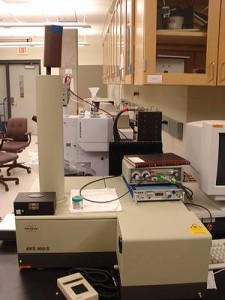Raman spectroscopy is similar to infrared spectroscopy in that it helps the researcher determine the vibrational, rotational and other low-frequency modes of a sample. A laser beam in the visible, near infrared, or near ultraviolet range is scattered by the sample and reacts with the phonons which result in shifting the laser photons. The energy shift is detected and output as a spectrum which can be interpreted to determine the different modes in the sample.
The GOM group at Iowa State University has two different Raman Spectrometers. The first is a Bruker FT-Raman Spectrometer and the second is a Renishaw Dispersive Raman Spectrometer. The difference between the two is that the Dispersive Raman uses a diffraction grating spectrometer to disperse the light scattered by the sample. The light is then detected by a multi-channel detector and the wavelengths of light are the detected Raman Spectra. The FT-Raman uses an interferometer that creates a path difference between the source and signal beams to create an interference pattern. From that interferogram, the Raman spectra are reconstructed.



